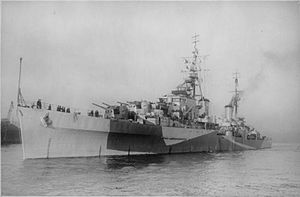PNS Jahangir
 |
|
| History | |
|---|---|
|
|
|
| Name: | HMS Diadem |
| Builder: | R. and W. Hawthorn, Leslie and Company, Limited (Hebburn-on-Tyne, UK) |
| Laid down: | 15 December 1939 |
| Launched: | 21 August 1942 |
| Commissioned: | 6 January 1944 |
| Decommissioned: | 1950 |
| Reclassified: | In reserve between 1950 to 1956 |
| Fate: | Sold to the Pakistan Navy on 29 February 1956 |
|
|
|
| Name: | Babur |
| Acquired: | 29 February 1956 |
| Commissioned: | 5 July 1957 |
| Renamed: | Jahangir |
| General characteristics | |
| Class and type: | Dido-class light cruiser |
| Displacement: |
|
| Length: |
|
| Beam: | 50.5 ft (15.4 m) |
| Draught: | 14 ft (4.3 m) |
| Propulsion: |
|
| Speed: | 32.25 knots (60 km/h; 37 mph) |
| Range: |
|
| Complement: | 530 |
| Armament: |
|
| Armor: | |
HMS Diadem was a Dido-class light cruiser of the Bellona subgroup of the Royal Navy. She was a modified Dido design with only four turrets but improved anti-aircraft armament - also known as Dido Group 2. She was built by R. and W. Hawthorn, Leslie and Company, Limited (Hebburn-on-Tyne), UK), with the keel being laid down on 15 December 1939. She was launched on 21 August 1942, and commissioned 6 January 1944.
Diadem served on the Arctic convoys and covered carrier raids against the German battleship Tirpitz in the early months of 1944, then became part of Force G off Juno Beach during the invasion of Normandy in June. After the landings she carried out offensive patrols against German shipping around the Brittany coast, sinking, with destroyers, Sperrbrecher 7 off La Rochelle on 12 August. She returned to northern waters in September, where she covered Russian convoys and carrier raids against German shipping routes along the Norwegian coast, as well as making offensive sweeps herself. In the course of one such sweep, accompanied by HMS Mauritius on 28 January 1945, the cruiser engaged three German destroyers, damaging Z31. Diadem remained with the 10th Cruiser Squadron until after the war, and served in the Home Fleet until 1950. She was placed in reserve between 1950 to 1956. She was sold to the Pakistan Navy (announced) 29 February 1956 and refitted at Portsmouth Dockyard before being handed over to the Pakistan Navy as Babur on 5 July 1957.
The refit was substantial, the light armament was standardised as 14 40 mm guns in three twin mounts, Mk 5 and eight single mounts. Radar was substantially updated to 974 navigation, 293 target indicator and air warning 281B at near 960 capability similar to HMS Euralyus in 1954. She was renamed Babur, after the founder of the Mogul empire.The cost of the refit, far exceeded the 400,000 pound allocated by the Pakistan Government even with considerable US MAP aid and with the work done by the Royal Navy dockyard below cost. The Royal and Pakistan Navy had known from the start of 1956 the refit cost far exceeded Pakistan budget, but the new RN First Sea Lord, Admiral Earl Mountbatten, as the last Viceroy, was determined Pakistan would have a cruiser as was head of Pakistan's Navy and the main proponent of the cruiser C-C Choudri, despite his governments attempt to first cancel the deal in mid 1957 and then demand the cruiser be decommissioned as an extravagance, when it arrived in 1958 and the British Government demanded a payment which even the British Far East Command considered outrageous and likely to promote a political crisis She was later renamed Jahangir, and defence cuts saw it temporarily laid up as a fully manned static training ship for cadets in 1961. However by 1963 the cruiser was back in full operational service and deployed as a fighting unit in a clash with India in 1965, and carried out a shore bombardment of Dwarka in September 1965. Fitting the cruiser with Styx missiles was considered in 1968 to counter Indian Naval, SOviet missiles, but Russia was not prepared to offer the missile only for FAC not larger cruisers and destroyers. The outbreak of war again with India in December 1971 saw the Babur deployed again as one of Pakistan's few available large warships, taking station 70 miles west of Karachi, in an outer patrol zone, intending to protect the major ports of West Pakistan and oil tankers from the Gulf. Pakistans light AA at Karachi and other ports and even the 40mm Mk 5/7s on the Diadem discouraged low level IAF bombing which would have been more effective than the Canberra raids that occurred on Karachi and led India to use its Styx Osa missile boats for its major strike against the Pakistan Navy and the Karachi port installations and tank farm. While the Pakistan naval group eventually detected the incoming FAC squadron on the third radar indication , an hour later one of Pakistan destroyers was sunk by a Styx missile fired at 20 miles range from an Osa. The Indian FAC squadron then proceeded to attack shipping in the Karachi vicinity and during the night hit Karachi oil refineries with a couple of Styx missiles causing a firestorm seen fro 60 miles. Babur lacking any anti missile ECM or chaf and the modern radar and processing needed to identify and distinguish air, missile boat and surface unit attack and was recalled to the naval base as a static flac ship
...
Wikipedia
